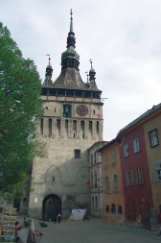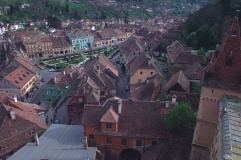 Drink the same waters as Napoleon III, walk through the narrow streets of an old mediaeval city and marvel at the stonework of a monastery, where in the walls lie the unquiet dead, in a three day tour around the treasures resting either end of the mysterious Olt valley. Drink the same waters as Napoleon III, walk through the narrow streets of an old mediaeval city and marvel at the stonework of a monastery, where in the walls lie the unquiet dead, in a three day tour around the treasures resting either end of the mysterious Olt valley.
From Ramnicu Valcea you can head north up the Olt Valley to Calimanesti-Caciulata, an old twin-spa resort which has alas lost much of its appeal since the days when it was one of Europe's most fashionable spa resorts. It was a favourite haunt of Napoleon III and was awarded a gold medal for its mineral waters at Vienna in 1873. The old Roman town comes to life during the first week of August, when it hosts a large folk music and crafts festival. Accommodation can be arranged through Calimanesti-Caciulata SR (tel. 0250-750 270; 413, Calea lui Traian).
The Monastery at Cozia was built by the Wallachian prince Mircea cel Batran in the late 14th century and today his tomb can be found there. The original fountain dates from 1517 and another was added by Constantin Brancoveanu in 1711. The complex also hosts a museum.
Sibiu
Founded in the 12th century on the site of the former Roman village of Cibinum, Sibiu (Hermannstadt to the Saxons, Nagyszeben to Hungarians) has always been one of the most important cities in Transylvania. During the peak of Saxon influence in the area, Sibiu had some 19 guilds, each representing a different craft, within the sturdy city walls protected by 39 towers and four bastions.  Under the Habsburgs from 1703 to 1791 and again from 1849 to 1867, Sibiu served as the seat of the Austrian governors of Transylvania and still retains many of the old buildings from this period, especially in the old town, one of the largest and best preserved in Romania. Under the Habsburgs from 1703 to 1791 and again from 1849 to 1867, Sibiu served as the seat of the Austrian governors of Transylvania and still retains many of the old buildings from this period, especially in the old town, one of the largest and best preserved in Romania.
There's no better place to begin your visit than at the top of the former Council Tower (Turnul Sfatului, 1588) which links Piata Mare with its smaller sister square, Piata Mica. Built as a defensive tower and later used as a cereal storehouse, it now houses a small History Museum (Muzeul de Istorie). The view of the Fagaras Mountains beckoning to the south is superb. Close by at Piata Mare 4-5 is the Brukenthal Museum (tel. 0269-217 691) the oldest and finest art gallery in Romania. Founded in 1817, the museum is in the baroque palace (1785) of Baron Samuel Brukenthal (1721-1803), former Austrian governor. Paltinis (Hohe Rinne) is a tourist resort built by Siebenburgischer Karpatenverein in 1894. Situated around 35 Km away from Sibiu, Paltinis is the highest (1,440 m altitude) and the oldest resort in Romania. The beautiful location, the fresh air, and the numerous hiking trails have made Paltinis a very popular tourist attraction.
Philosopher Constantin Noica's grave is at Schit Church on the road to Sibiu. The house where he spent his last years, Noica House, reveals much about his life and work. From Paltinis, it is very easy to reach the main attractions in the surrounding mountains. The red-dot trail leads northwest toward Cheile Cibinului (5 Km). The red-cross trail follows an unpaved road toward Vf. Batrana (Old Woman's Peak), at 1,911 m. The 25 km long red-strip trail to the Cindrel peak (2,244 m) is a more difficult one, but has marvellous scenery on the way of the peak. Ski slopes are arranged for alpine skiing. Curtea de Arges Curtea de Arges, a princely seat in the 14th century after the capital of Wallachia was moved here from Campulung Muscel, is a welcoming place for visitors. The ruins of Curtea de Arges's 'Princely Court' (Curtea Domneasca), which originally comprised a church and palace, are in the center. The church was built in the 14th century by Basarab I, whose statue stands in the square outside the entrance to the court.
Back in the centre, walk past the Princely Court and head north along Basarabilor St. for one km until you reach Curtea de Arges Monastery (Manastirea Curtea de Arges). The fantastic Episcopal cathedral was built between 1514 and 1526 by Neagoe Basarab (reigning 1512-21) with marble and mosaic tiles from Constantinople. Local legend has it that according to a local custom, the stone mason who built the walls of the church was obliged to bury his beloved within these walls to ensure the success of his work. Manole, the stone mason, could not bear going on with his life without his wife, so he killed himself. But this myth, as any central and eastern European scholar knows, pops up in many Balkan countries. |
Long Weekend Calimanesti-Caciulata - Sibiu – Transfagarasan |
Day 1 Bucuresti Manastirea Cozia - Calimanesti-Caciulata (accommodation)
Day 2 Sibiu (Council Tower, History Museum, Brukenthal Museum, Piata Mare, Piata Mica, Staircase Passage, Staircase Tower) - Cisnadie Rasinari - Paltinis (accommodation)
Day 3 Paltinis - Sibiu - Transfagarasan - Vidraru Lake- Curtea de Arges (Princely Court, Curtea de Arges Monastery) Bucuresti. |
|